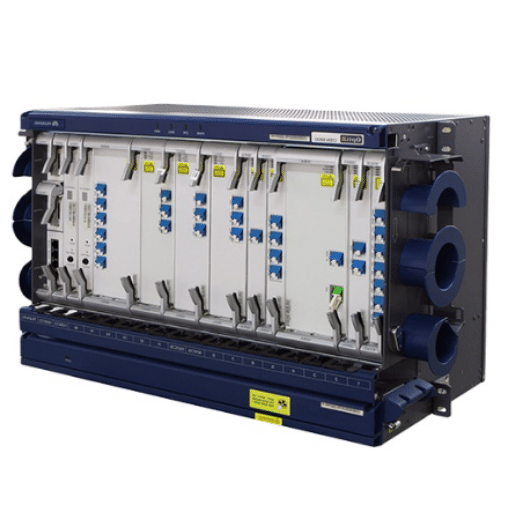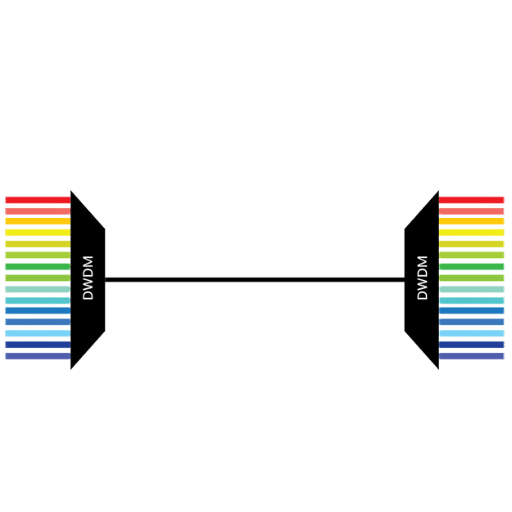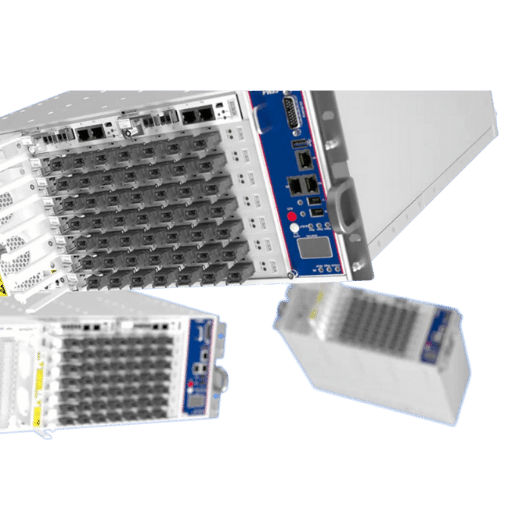The following will tell you what is DWDM and WDM.
Wavelength division multiplexing (WDM) is a technology used in fiber optic communication to increase the capacity and speed of data transmission. It is based on the principle that light can have different wavelengths, which can be used to carry other signals simultaneously. Using WDM, multiple signals can be transmitted through a fiber optic cable without interfering.
Recommended Reading: Thinking about the capacity limits of WDM systems
WDM works by separating the light signals using different wavelengths and combining them at the receiving end. This is achieved by using special devices called multiplexers and demultiplexers. Multiplexers combine the various movements into a single fiber, while demultiplexers separate the signs at the receiving end. WDM can be divided into Coarse WDM (CWDM) and Dense WDM (DWDM).

The benefits of using WDM include higher bandwidth, scalability, and cost-effectiveness. With WDM, multiple signals can be transmitted through a single fiber optic cable, increasing data transmission capacity. It is also scalable, meaning more wavelengths can be added without additional fibers. This makes it a more cost-effective solution than using multiple threads.
CWDM uses wider spacing between wavelengths, typically 20nm apart. It is cost-effective and suitable for shorter distances, up to 80km. On the other hand, DWDM uses tighter spacing between wavelengths, typically 0.8nm apart. It allows for higher bandwidth and longer distances, up to thousands of kilometers. DWDM is often used in long-distance telecommunications and internet service providers.
WDM is an essential technology in fiber optic communication that allows for higher capacity, speed, and cost-effectiveness. WDM has expanded communication possibilities and improved various industries by using different wavelengths to transmit multiple signals through a fiber optic cable. With its ability to increase bandwidth, scalability, and efficiency, WDM continues to be a valuable asset to the world of technology.
Dense wavelength division multiplexing (DWDM) is a sophisticated technology that allows sending multiple data streams over a single optical fiber using different light colors, also known as wavelengths. The technology enables transmitting high-capacity data over longer distances with less interference, making it a vital tool in modern transport networks.
While traditional wavelength division multiplexing (WDM) divides the fiber bandwidth into several fixed channels, DWDM can squeeze many more wavelengths in the same fiber while maintaining high signal integrity. The traditional WDM typically allows between eight and 48 tracks, while DWDM can achieve a significantly higher number of media, and some vendors offer up to 96.
DWDM also covers a more extensive range of wavelengths than traditional WDM, which uses wavelengths separated by large bandwidths to avoid crosstalk. By contrast, DWDM uses a more refined approach, reducing the channel spacing to allow for denser channel allocation. This difference results in DWDM having more capacity over more extended distances.

DWDM combines – or multiplexes, as it’s called technically – various optical signals in different colors (wavelengths) on a single strand of fiber, so the data transmission capacity is maximized. DWDM systems use a series of fiber optic amplifiers to intensify and maintain the optical signals, reducing the number of regenerations required. In other words, DWDM packs more data onto a single fiber strand while optimizing network performance.
Recommended Reading: What is OEO in WDM system
DWDM uses channels to separate data signals, and each channel can carry a specific amount of data transmitted as the light of a particular wavelength. The more media can be shared, the more data can flow through the network. Each DWDM channel can operate independently and use any wavelength, making it possible to send multiple data types simultaneously. The individual channels can be separated readily, allowing easier data management.
DWDM has several advantages, including higher capacity, longer transmission distances, and fewer regenerations or repeaters required. With DWDM technology, service providers can deploy higher-capacity networks at a more affordable price, providing an economic advantage over traditional transmission technologies. DWDM also reduces the need for multiple network layers, making it easier to manage and less complex.
Furthermore, DWDM provides the flexibility to transport different data types simultaneously and reduces the amount of fiber cabling required, making installations more manageable and less costly.
DWDM uses transmitting and receiving equipment and optical amplifiers to strengthen the signal as it travels across a fiber network. With DWDM, data is transmitted in light waves, each at a different frequency and carrying a unique data stream. The waves are combined with multiplexers, and the signal is amplified by a series of amplifiers, boosting its strength. The data is then transmitted over the fiber network to the destination point, separated into its constituent channels.
DWDM can be integrated into transport networks, allowing service providers to transport multiple types of traffic, such as high-definition video, real-time voice communication, and data simultaneously. This capability provides significant benefits for businesses in industries such as telecommunications, healthcare, education, and finance that require the transmission of large amounts of data quickly and efficiently.
DWDM (Dense Wavelength Division Multiplexing) technology is a sophisticated optical multiplexing technology that simultaneously allows multiple data streams to travel over a single fiber optic cable. To understand DWDM better, let’s dive into its critical components and how it operates in detail.
Transceivers: These devices transmit and receive data over the fiber optic cable. Transceivers convert electrical signals to optical signals and vice versa.
Optical Amplifiers: Optical amplifiers are essential components of DWDM systems that amplify weak optical signals and boost them to their original strength. Amplifiers are necessary to transmit data over long distances without significant signal degradation.
Multiplexers: Multiplexers combine signals from different sources and transmit them over a fiber optic cable. Multiplexers use different wavelengths of light for each call.
Demultiplexers: Demultiplexers split out the different signals and allow them to be received by the appropriate end devices.
Optical amplifiers are crucial components of DWDM technologies that amplify the optical signals that tend to weaken as they travel long distances. The amplification process strengthens the movement, allowing it to continue its long journey without degradation. There are two optical amplifiers – Erbium-Doped Fiber Amplifiers (EDFAs) and Raman Amplifiers.
Multiplexing is the process of combining multiple signals and transmitting them over a single fiber optic cable. DWDM technology uses wavelength division multiplexing (WDM), which combines multiple data streams with different wavelengths onto a single fiber optic cable. Using various wavelengths, DWDM can accommodate several signals on a single line without interference.
The wavelength channels or color of light used in DWDM technology are crucial aspects that allow for the efficient transmission of data. Each track carries a unique wavelength assigned to a particular data stream. Hence, this allows multiple data streams to be compressed into a single fiber optic cable, and different wavelengths ensure that the signals do not interfere.
The spacing between channels or the distance between the wavelengths used in DWDM systems is essential to ensure data is efficiently transmitted without interference. The International Telecommunication Union (ITU) has set the standard channel spacing at 50 GHz for DWDM systems.
DWDM solutions can be implemented in existing fiber networks via overlay or integration. Overlay refers to installing DWDM equipment and devices alongside existing fiber optic infrastructure. Integration refers to replacing existing equipment with DWDM systems to increase data transmission capacity.
DWDM technology is ideal for organizations with large data transmission needs over fiber networks. The implementation of DWDM provides numerous advantages, including increased network capacity, improved quality of service, and more efficient data transmission. By utilizing DWDM’s critical components – optical amplifiers, multiplexers, demultiplexers, and WDM- businesses can easily manage their data transmission requirements and optimize their fiber optic networks for future growth.
Recommended Reading: Can you read WDM in a minute
DWDM technology has emerged as the most potent multiplexing technology for network engineers in recent years. Its advantages over other multiplexing techniques such as CWDM, FDM, and TDM include increased bandwidth, longer transmission distances, improved fiber capacity, and economic benefits such as space and cost savings.

One of the most significant advantages of DWDM is its ability to provide higher bandwidth. With DWDM, multiple wavelengths of light are transmitted simultaneously over a single fiber optic cable. This allows for a significant increase in the capacity of the fiber optic cable and enables network engineers to transport more data over a single fiber optic cable. This capability is critical in meeting the escalating demands for high-speed and high-bandwidth data services from consumers and businesses.
DWDM technology significantly increases fiber capacity due to its ability to multiplex signals across multiple wavelengths of light. Multi-wavelength transmission enables network engineers to increase the transmission rate of fiber optic cables, enhancing the capacity of fiber infrastructure. This allows networks to expand without additional fiber optic cables and other equipment necessary to support such growth.
DWDM technology also provides significant space and cost savings. Using DWDM technology reduces the need for multiple fiber optic cables and other associated equipment, reducing space requirements in data centers, long-haul networks, and telecommunications systems. Reducing space requirements helps make data centers more energy-efficient and creates cost savings for network engineers in the long run.
Another benefit of DWDM technology is its ability to enable longer transmission distances without complex equipment. The long transmission distances made possible by DWDM allow for the deployment of fiber optic cables over long distances. This enhances network coverage, providing connectivity to remote areas that require expensive equipment.
In comparison to other multiplexing technologies, DWDM technology has several advantages. Unlike other multiplexing techniques, DWDM offers higher bandwidth, increased fiber capacity, longer transmission distances, and cost and space savings. These advantages make DWDM popular for data centers, telecommunications companies, and long-haul networks.
Recommended Reading: WDM transmission engineering networking scheme
Regarding multiplexing technologies in telecommunications, Coarse Wavelength Division Multiplexing (CWDW) and Dense Wavelength Division Multiplexing (DWDM) are two popular options. Although they both serve the same purpose of combining multiple signals onto a single fiber, some key differences make them better suited for different applications.
One of the main differences between CWDW and DWDM is the channel spacing, which refers to the wavelength intervals between channels. CWDW typically uses wider channel spacing, around 20 nanometers, while DWDM uses much narrower channel spacing, around 0.8 nanometers. This means that DWDM can fit many more channels onto a single fiber.
Another difference is the fiber capacity. CWDW can typically support up to 18 channels on a single fiber, while DWDM can support up to 96 channels or more. This makes DWDM more suitable for high-capacity applications.
CWDW and DWDM can coexist in a network since they operate on different channel spacing. However, care must be taken to prevent interference between the two technologies.
CWDW is often preferred for applications requiring lower capacity and shorter distances, such as within buildings or campus networks. On the other hand, DWDM is preferred for longer transmission distances and higher capacity requirements, such as backbone networks.
There are several benefits to using DWDM over CWDW. Since DWDM can support many more channels on a single fiber, it allows for much greater transmission capacity and can reduce the number of threads required for a network. Additionally, DWDM provides greater wavelength flexibility, allowing for more efficient use of the available bandwidth.
Recommended Reading: Next-generation DWDM optical module based on PAM4 modulation

A: DWDM combines optical signals on a different wavelength onto a single optical fiber. Depending on the system, the wavelengths are spaced closely together, typically around 0.8 or 0.4nm apart. The signals are multiplexed and demultiplexed at the ends of the fiber using specialized equipment.
A: There are several advantages to using DWDM technology. Firstly, it allows transmitting many channels, typically up to 80, over a single fiber. This dramatically increases the capacity of the network. Secondly, DWDM offers flexibility in terms of wavelength allocation, allowing for easy configuration and management of the network. Additionally, it is a cost-effective solution as it can utilize existing fiber infrastructure.
A: DWDM and CWDM (Coarse Wavelength Division Multiplexing) are WDM (Wavelength Division Multiplexing) technology forms. However, they differ regarding the spacing of the wavelengths and the number of channels they can support. DWDM uses tighter wavelength spacing, typically around 0.8 or 0.4nm apart, and can keep many channels, typically up to 80. CWDM, on the other hand, uses wider wavelength spacing, generally around 20nm apart, and can support fewer channels, typically up to 16 channels.
A: The main difference between traditional DWDM and CWDM is the spacing of the wavelengths. Traditional DWDM uses tighter wavelength spacing, typically 0.8nm or 0.4nm apart, while CWDM uses wider wavelength spacing, usually 20nm apart. This difference in spacing allows traditional DWDM to support more channels, up to 80 channels, compared to CWDM’s maximum of 16 tracks.
A: A DWDM wavelength refers to the specific wavelength of light used to carry a signal in a DWDM network. Each channel in a DWDM system is assigned a particular wavelength, usually in the C-band or L-band of the optical spectrum.
A: The distance that DWDM signals can travel depends on several factors, including the quality of the fiber and the optical amplification used. DWDM signals can generally travel thousands of kilometers without being regenerated or amplified.
A: The capacity of a DWDM network depends on several factors, including the number of channels supported and the data rate of each track. A typical DWDM system can keep up to 80 channels, each operating at data rates of 10Gbps or higher. This results in a total capacity of several terabits per second.
A: DWDM technology is used in various network applications, including long-haul and metro optical transport, interconnectivity between data centers, and high-speed internet backbone networks. It is also used in submarine and terrestrial fiber optic networks.
A: Generally, DWDM is more expensive than CWDM. This is because DWDM requires more precise equipment and offers higher capacity, which adds to the overall cost of the system. CWDM, on the other hand, has wider wavelength spacing and is more cost-effective for applications that don’t require the same high capacity level.